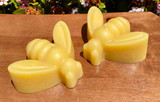June is Pollinator Month!
This month we're writing about pollinator friendly gardens, what they are and how you can create one.
Pollinator friendly gardens are gardens that are designed to attract and support pollinators like bees, hummingbirds, butterflies, moths, and other insects necessary for plant reporoduction.
Here are a few key features you'll want to include to create a pollinator friendly garden at home.
- Native plants, diversity, and layering: Native species are conducive to the natural environment and provide local pollinators with the right types of nectar and pollen. Include a variety of flower shapes, sizes, and colors to attract different pollinators. Plant in layers to support different sizs and types of pollinators including trees, shrubs, perennials, and ground covers for a varied habitat.
- Staggered bloom times and overlapping periods: Choose plants that flower at different times of the year so that your garden is always attracting some type of pollinator. Typically you will want plants that flower from early spring through late fall. Ensure something is blooming to support pollinators year-round will create a safe and consistant environment for them to come to.
- Avoiding harsh garden chemicals: Avoiding harsh pesticides and opting for organic or alternative pest control options may help attract and keep pollinators healthy and visiting your garden.
- Provide nesting and shelter: Include areas of bare ground and undisturbed soil for ground-nesting bees and insects. Offer "bee hotels" or small tubes and drilled wood for solitary bees. small bundles of dead wood or brush can be used by beetles, moths, and carpenter bees. And dense shrubs or hedges give cover and protection for many pollinators.
- Water sources: provide shallow water sources by placing small, shallow dishes with pebbles or floating corks for insects to land. think of these as miniature watering holes for your pollinators. Be sure to refresh your water sources regularly to avoid mosquito breeding and unwanted growths.
- Intentional planting: some pollinators, like butterflies, need specific plants to lay eggs on such as milkweed. if you want to attract a certain type of pollinator you might want to look into which plants are most suitable for them.
- Maintain and observe: As you plant and grow your pollinator friendly garden, be sure to maintain it by removing invasive plants, thinning out and refreshing overgrown areas, and adjusting plants as needed depending on which pollinators youre attracting.
We hope you get to celebrate Pollinator Month by growing your pollinator friendly gardens and that this post has helped you get started!

